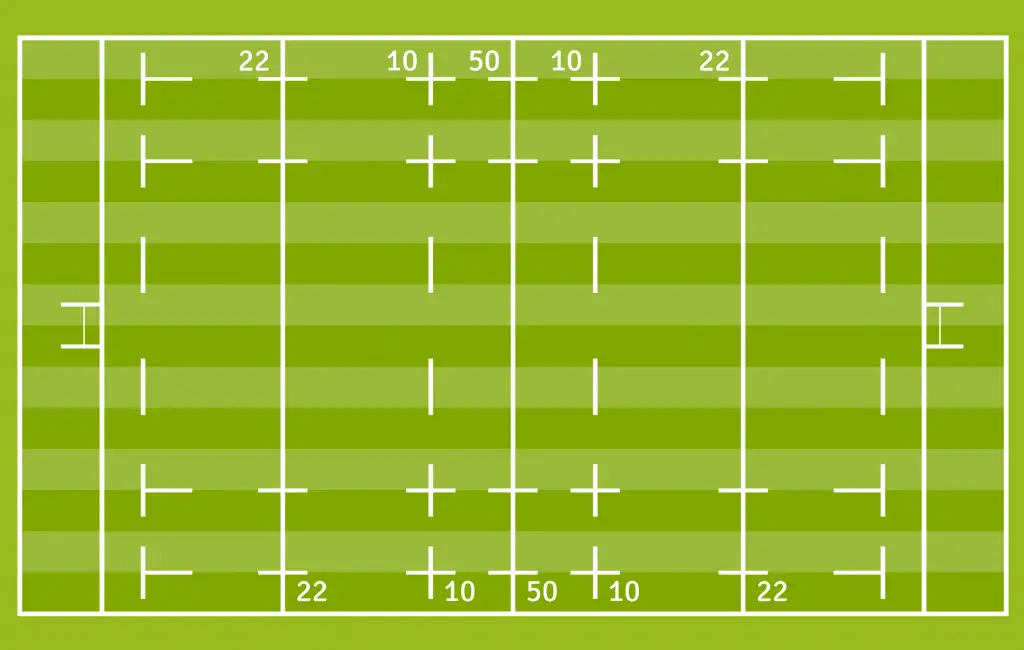
Rules on the dimensions of a rugby field (also known as a rugby pitch) are relatively straight-forward. The World Rugby governing body wants the game to be as accessible as possible for the many fans enjoying the game. Here, we’ll go over the rugby field dimensions and the different lines on the pitch and what they mean.
How big is a rugby field?
Most rugby fields are 100 meters in length from goalpost to goalpost, however, the World Rugby laws state that 94 to 100 meters is acceptable. The width of the field can range anywhere from 68 to 70 meters between touchlines. Behind each goalpost is what’s called an in-goal area where a try can be scored.
These areas must be the same width as the field, but can be anywhere from 6 to 22 meters in length. The rules also state that the playing field must be rectangular in shape and any changes in field dimensions must be approved by the relevant union or domestic competition.

What are the lines on a rugby field?
Dead-ball Line
The first line is called the dead-ball line which is roughly 6 to 22 meters away from the try line. If the ball crosses the dead-ball line, the following things may happen:
- If the attacking team kicks the ball and it goes over the dead-ball line, the defending team will have a scrum from where the attacking team kicked the ball.
- If the defending team kicks the ball from in-field over the dead-ball line, the attacking team will have a scrum from the 5 meter line. If the defending team kicks the ball from the in-goal area over the dead-ball line, the defending team will take a 22 meter drop out.
Try Line
The next line we’ll look at is the try line (or some call it the goal line). The try line is where a try can be scored either on the line or in the in-goal area. The try line is in line with the goalposts and spread from touchline to touchline. You may notice protective pads on the goalposts (to ensure players aren’t at risk of hitting the metal posts). The protective pads must be no thicker than 0.3 meters because if you place the ball at the bottom of the protective pad, you will be awarded a try. 5 meters in front of the try line is the 5 meter line. The 5 meter line isn’t a line that spreads the width of the field, but they’re to show where a 5 meter scrum should be taken from.
22 Meter Line
The next line is called the 22 meter line which is 22 meters away from the try line. This is where a 22 meter drop out is taken, however, the kicker can opt to take it behind the 22 meter line if he wants. On both the left and right side of the 22 meter line, there are two lines on each side of the pitch which cross perpendicularly (5 meters and 15 meters away from the touchline). These perpendicular lines are to ensure a lineout can happen properly as all players in the lineout must be standing between these two lines, along with the ball that must go beyond the 5 meter line.
10 Meter Line
The 10 meter line is 10 meters away from the halfway line and is dotted across the field. This line is significant as any kickoffs must go past the 10 meter line. If they do not pass the 10 meter line, the opposing team is awarded a scrum on the halfway line.
Halfway Line
The halfway line is where kickoffs are taken when a match is restarted. If the pitch length is shorter than 100 meters, the lengths between each line will be shortened accordingly and the same applies if the width of the pitch is less than 70 meters.
Other Lines
On the opposition’s side, you will see identical lines. There are also two touchlines one on either side of the field which run the length of the pitch (94 to 100 meters.) If a lineout is given, the hooker will stand on the touchline and throw the ball into the lineout. There is also a touch in-goal line which runs from the try line to the dead-ball line. If the ball crosses this line, rules regarding the dead-ball line apply. Outside of the field of play, there is a perimeter which is designed to keep fans off the field in lower league games. The perimeter cannot be less than 5 meters away from the touchline and dead ball line.
The Goalposts and Flags
There are also regulations on the size of the goalposts where kickers gain points through penalties, conversions, and drop goals. The crossbar must be 5.6 meters in length and 3 meters above the ground. The total height of the posts must be a minimum of 3.4 meters. There are also 14 different flags used around the field in Rugby Union, including 4 flags at each intersection of the touchline and the try line, and 4 flags at each intersection of the in-goal touchline and the deal-ball line. The other 6 flags are located on either side of the halfway line and both sides of the 22 meter lines. If a ball carrying player touches a flag, he is not in touch and he can continue running.
The Referee’s Inspection
Before a game can get underway, the referee must complete a pitch inspection to make sure the pitch is not waterlogged and that there are no dangerous objects on the pitch. Either team can make an objection before the match starts, however, it is ultimately up to the referee.
Rugby pitch vs rugby field, which is it?
Well, it depends where you’re from. In the U.S. there are 1,800 monthly Google searches for “rugby field,” compared to only 450 searches for “rugby pitch.” Conversely, in the U.K. there are 1,500 searches for “rugby pitch” and only 300 searches for “rugby field.” Like football (soccer) it’s all the same thing, just referred to by a different name.
How does a rugby field compare to a football field?
Rugby and football fields are similar in some ways but there are also some key differences. Here are the two main ways in which rugby fields compare to football fields:
- Size: a rugby field is typically larger than an American football field. A standard rugby field is 100 meters long and 70 meters wide, which equates to approximately 109 yards by 77 yards. In contrast, a standard American football field is 100 yards long and 50 yards wide, or approximately 91 meters by 46 meters.
- Markings: Rugby fields have several markings that football fields do not have. For example, football field have a line at every 5 yards. Rugby fields have markings for the 22-meter line, which is the line that marks the distance from the try line that a ball must travel on a kick in order to result in a drop-out.
Check out our article explaining the differences between rugby and American football.
